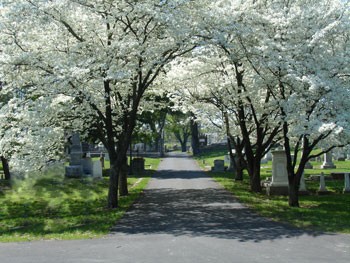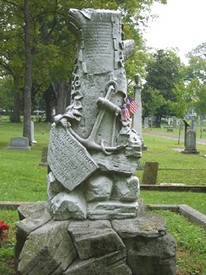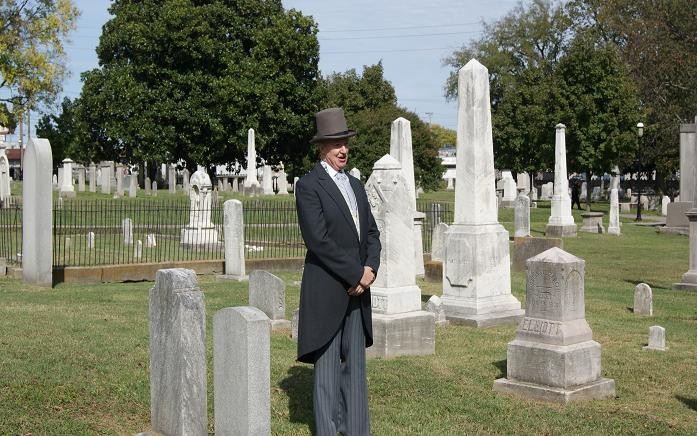Nashville City Cemetery
Introduction
Text-to-speech Audio
The Nashville City Cemetery, located at 1001 Fourth Avenue South at Oak Street, was established in 1820 and opened in 1822. It is the oldest continuously operating public cemetery in Nashville. Many distinguished pioneers and citizens of the city found their final resting place here, including James Robertson, the founder of Nashville. Civil War soldiers were also buried here, though many of these -- including some who fought for the Union -- were later disinterred and re-interred elsewhere after the war. This is also the burial place of the Unionist sea captain William Driver, who coined the term "Old Glory," which was to become the enduring nickname for the US flag.
Nashville Mayor Ben West, beginning in 1958, led restoration and preservation efforts at the cemetery (and was eventually buried there himself), and a second restoration effort, begun in 2006, was recently completed. In 1972, it was listed in the National Register of Historic Places due to its architectural and historic significance.
The Nashville City Cemetery Association (NCCA) manages the location and has carefully maintained records of its tombstones and inscriptions, and the NCCA has made these available not only to visitors to the site but online.
Images
Dogwood trees at the Nashville City Cemetery

The tombstone of Capt. William Driver, with an anchor symbolizing his occupation as a seaman

Living History tour guide at the cemetery

Backstory and Context
Text-to-speech Audio
On March 9, 1820, Nashville Mayor Thomas Crutcher and the city alderman purchased four acres near St. Cloud Hill from Richard Cross to establish a cemetery (the old one having been flooded), and it opened on January 1, 1822. The city made additional purchases to expand the cemetery between 1836 and 1856, by which time it contained over 20,000 graves, which included the remains of people of all races and religions. Four of Nashville's founders, James and Charlotte Robertson and John and Ann Robertson Cockrill, are buried there. The distinguished Revolutionary War officer Lipscomb Norvell, the father of a U.S. Senator, was also interred there, as were four Confederate generals, including one Ohio-born one, Gen. Bushrod Johnson.
One of the more colorful figures among those who found their final resting place in the city cemetery was the New England-born sea captain William Driver, who had, in his youth, sailed the world on a ship flying a homemade US flag he nicknamed "Old Glory." Settling in Nashville before the Civil War, he remained fiercely loyal to the Union after secession, and was so determined to resist all Confederate attempts to seize his worn old flag that he had it sewn into a coverlet. When Nashville was occupied by the Union Army, Driver made his way to the Federal commander, Gen. William "Bull" Nelson, and without explanation ripped open the coverlet with a jackknife, revealing the tattered banner. Gen. Nelson ordered it raised over the statehouse to cheers from the men of the Sixth Ohio, and the name forever after became associated with that military unit -- and with all United States flags.
In 1908, engineer Felix Randolph Robertson Smith conducted the first surveys of the cemetery, resulting in the Plat Map of the cemetery, a list of Inscriptions on Tombstones (1908) and a List of the Dead (1909). For 16 years beginning in 1954, Jill K. Garrett and Iris H. McClain worked on recording the inscriptions on tombstones, and these were published in 1971. All this data is currently available online at NCCA's website, in addition to published obituaries for many of the dead.
The board of the NCCA partners with the Metro Board of Parks & Recreation and the Metro Historical Commission, and the organization throughout the past decade has worked closely with the Commission to preserve and restore the cemetery and to increase public awareness of it. The Davidson County Master Gardeners maintain the gardens throughout the site, planting only historically accurate plants and flowers, depending on the age of each section of the cemetery, and they occasionally give guided tours. The NCAA website offers a downloadable guide to the cemetery, which contains a map with a key to the locations of the graves of many distinguished figures in Tennessee history.
One of the more colorful figures among those who found their final resting place in the city cemetery was the New England-born sea captain William Driver, who had, in his youth, sailed the world on a ship flying a homemade US flag he nicknamed "Old Glory." Settling in Nashville before the Civil War, he remained fiercely loyal to the Union after secession, and was so determined to resist all Confederate attempts to seize his worn old flag that he had it sewn into a coverlet. When Nashville was occupied by the Union Army, Driver made his way to the Federal commander, Gen. William "Bull" Nelson, and without explanation ripped open the coverlet with a jackknife, revealing the tattered banner. Gen. Nelson ordered it raised over the statehouse to cheers from the men of the Sixth Ohio, and the name forever after became associated with that military unit -- and with all United States flags.
In 1908, engineer Felix Randolph Robertson Smith conducted the first surveys of the cemetery, resulting in the Plat Map of the cemetery, a list of Inscriptions on Tombstones (1908) and a List of the Dead (1909). For 16 years beginning in 1954, Jill K. Garrett and Iris H. McClain worked on recording the inscriptions on tombstones, and these were published in 1971. All this data is currently available online at NCCA's website, in addition to published obituaries for many of the dead.
The board of the NCCA partners with the Metro Board of Parks & Recreation and the Metro Historical Commission, and the organization throughout the past decade has worked closely with the Commission to preserve and restore the cemetery and to increase public awareness of it. The Davidson County Master Gardeners maintain the gardens throughout the site, planting only historically accurate plants and flowers, depending on the age of each section of the cemetery, and they occasionally give guided tours. The NCAA website offers a downloadable guide to the cemetery, which contains a map with a key to the locations of the graves of many distinguished figures in Tennessee history.
Sources
http://self.gutenberg.org/article/WHEBN0001556143/Nashville%20City%20Cemetery (sourced from World Heritage Encyclopedia)
http://www.thenashvillecitycemetery.org/historical_commission_cemetery_brochure.pdf
http://www.thenashvillecitycemetery.org/history.htm
http://www.bonps.org/tour/oldcitycem.htm
http://www.smithsonianmag.com/history/how-the-flag-came-to-be-called-old-glory-18396/?no-ist=&page=2
http://www.thenashvillecitycemetery.org/1909listofdead.htm
http://www.thenashvillecitycemetery.org/tombstones.htm
http://www.thenashvillecitycemetery.org/events.htm
